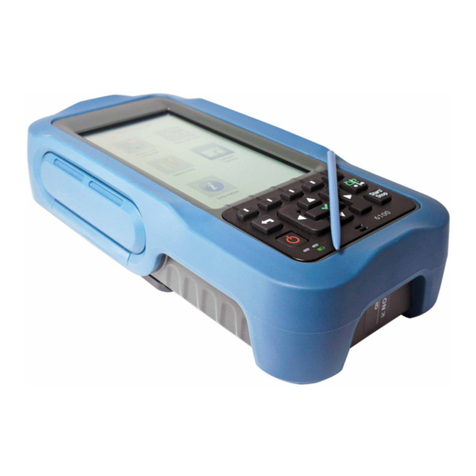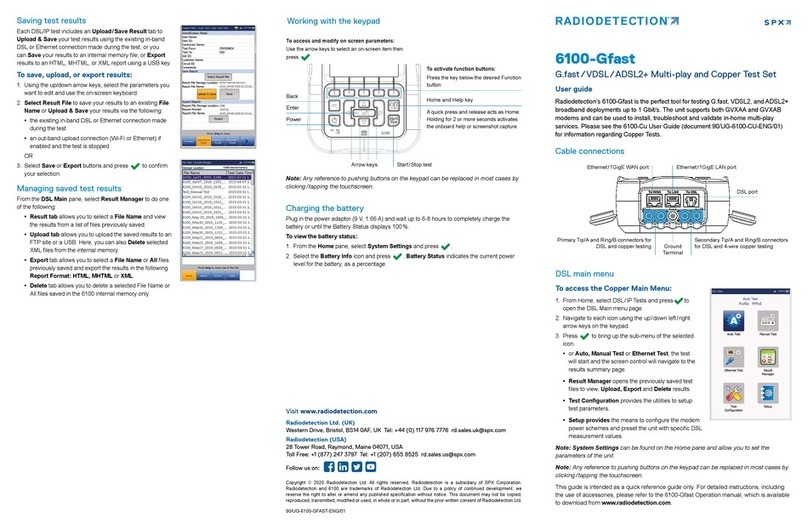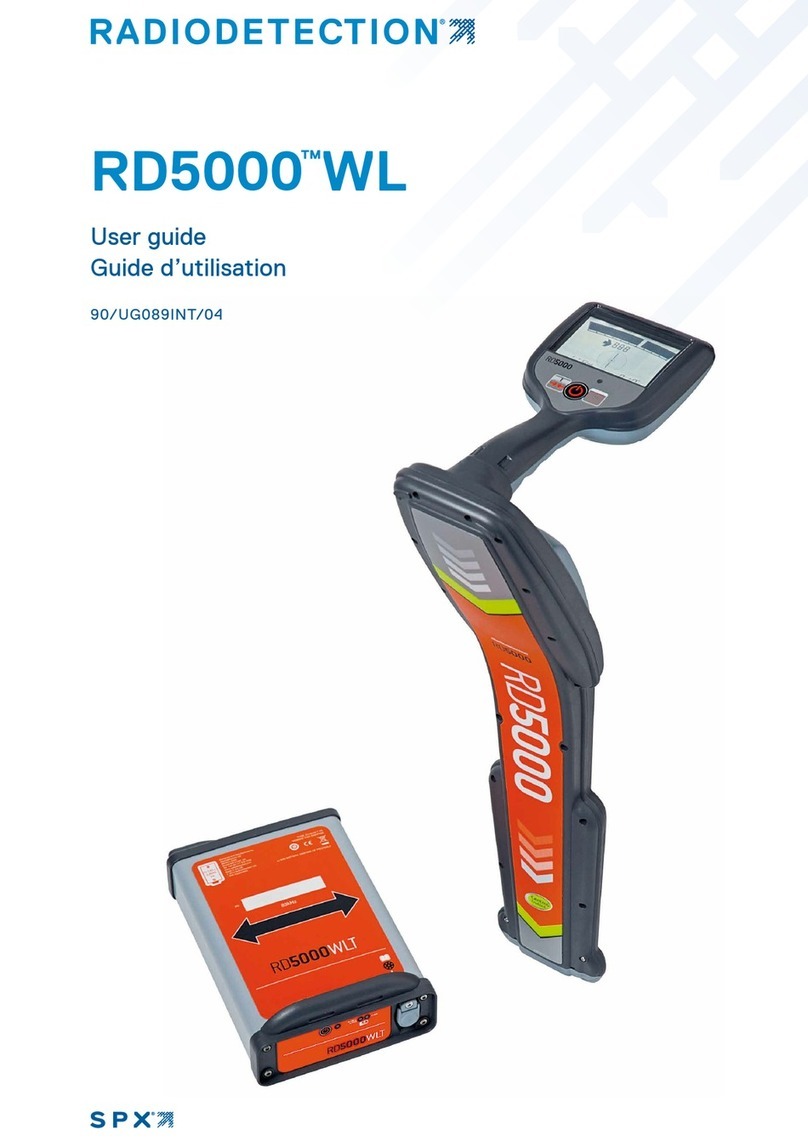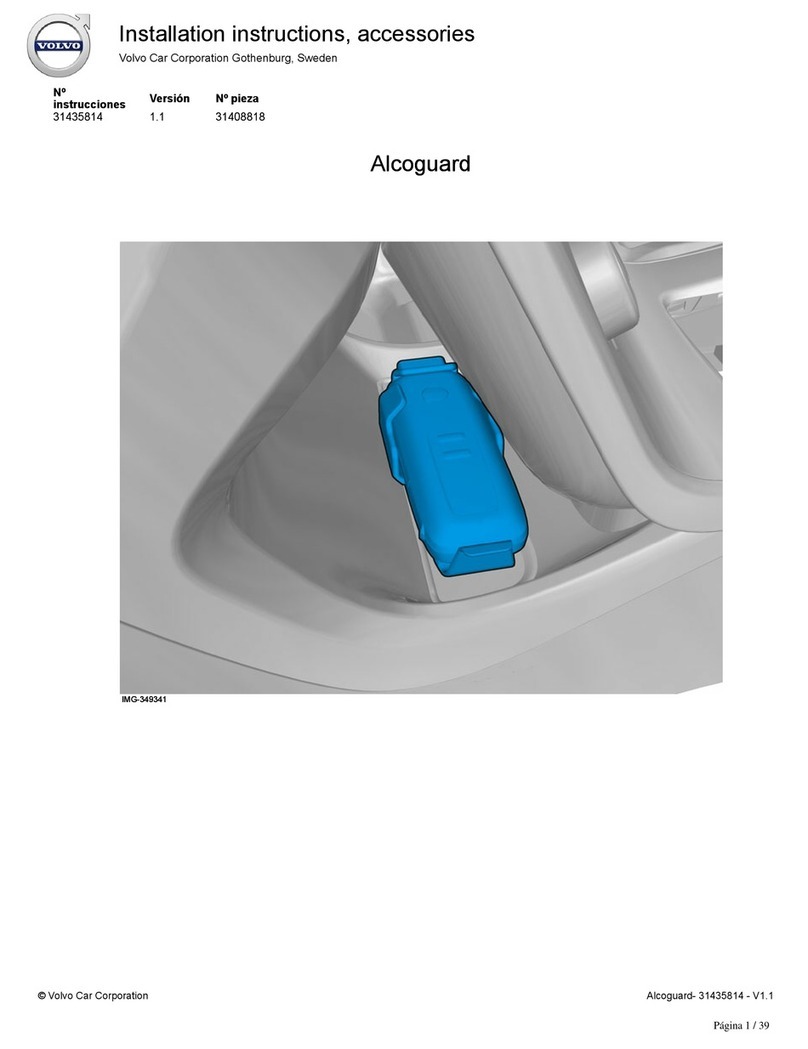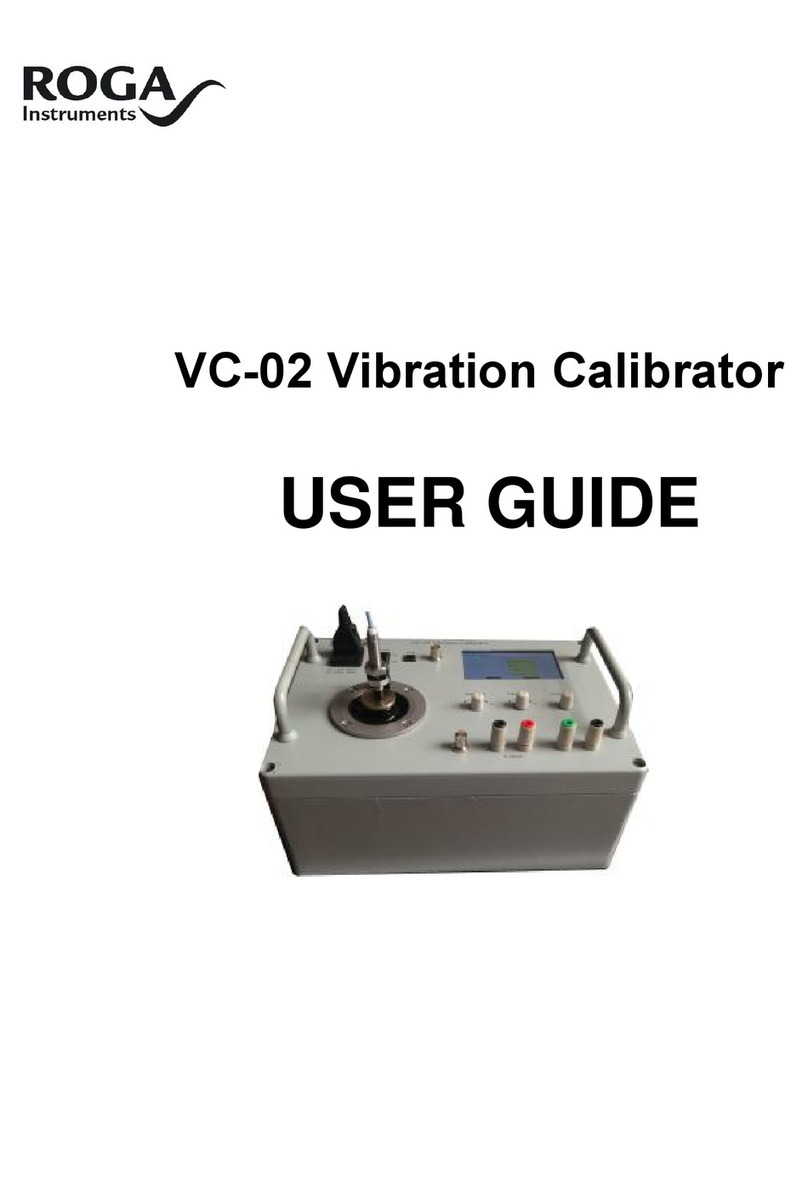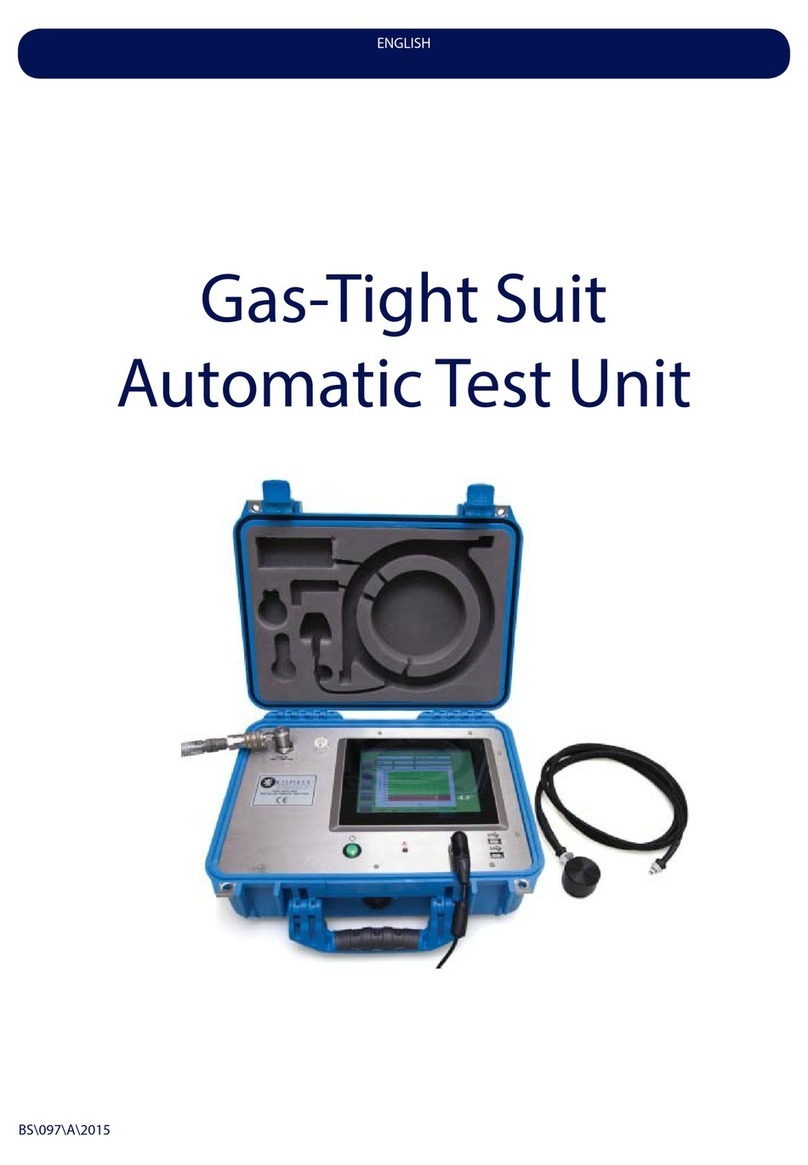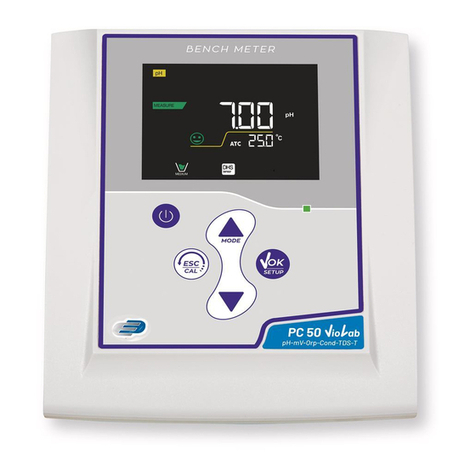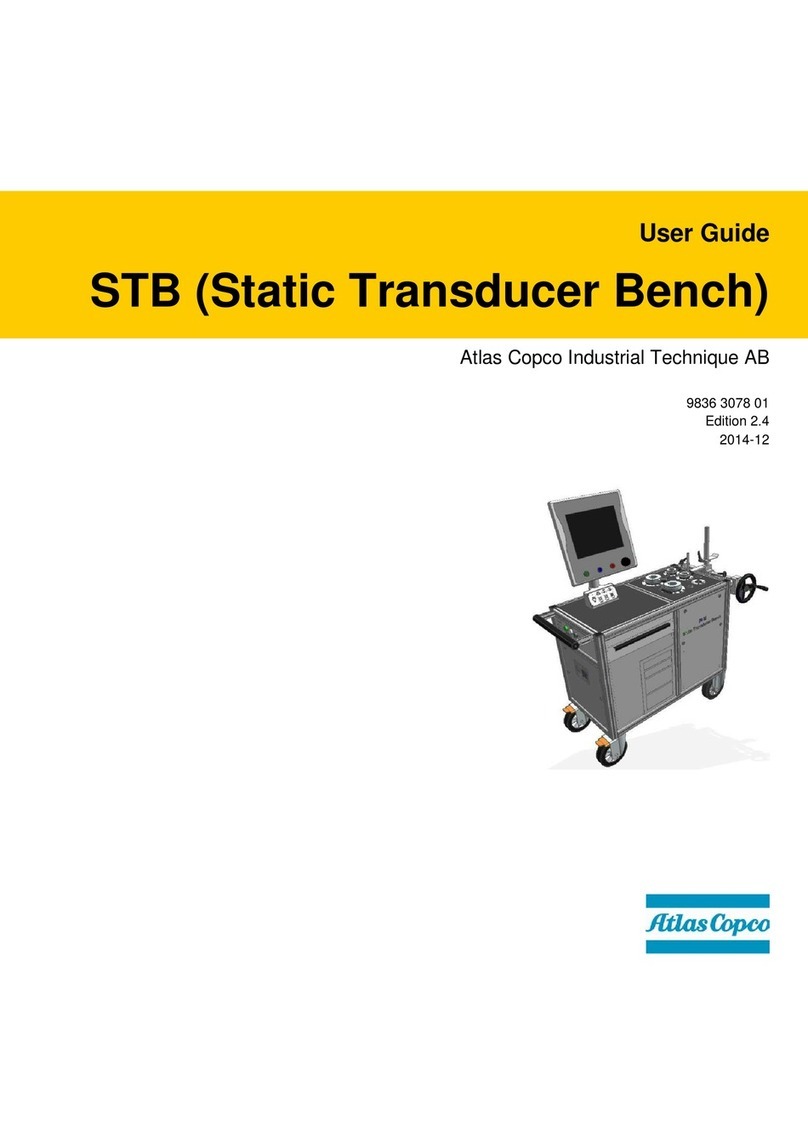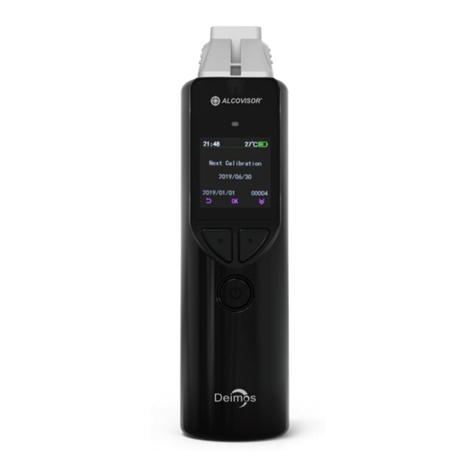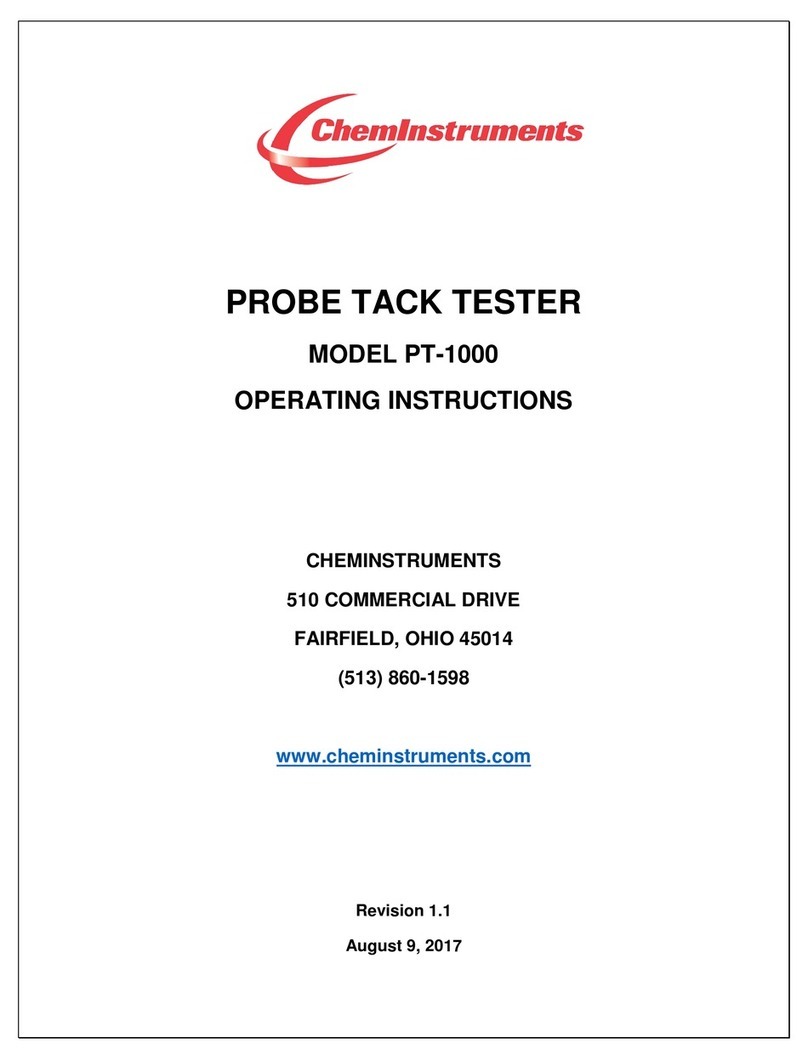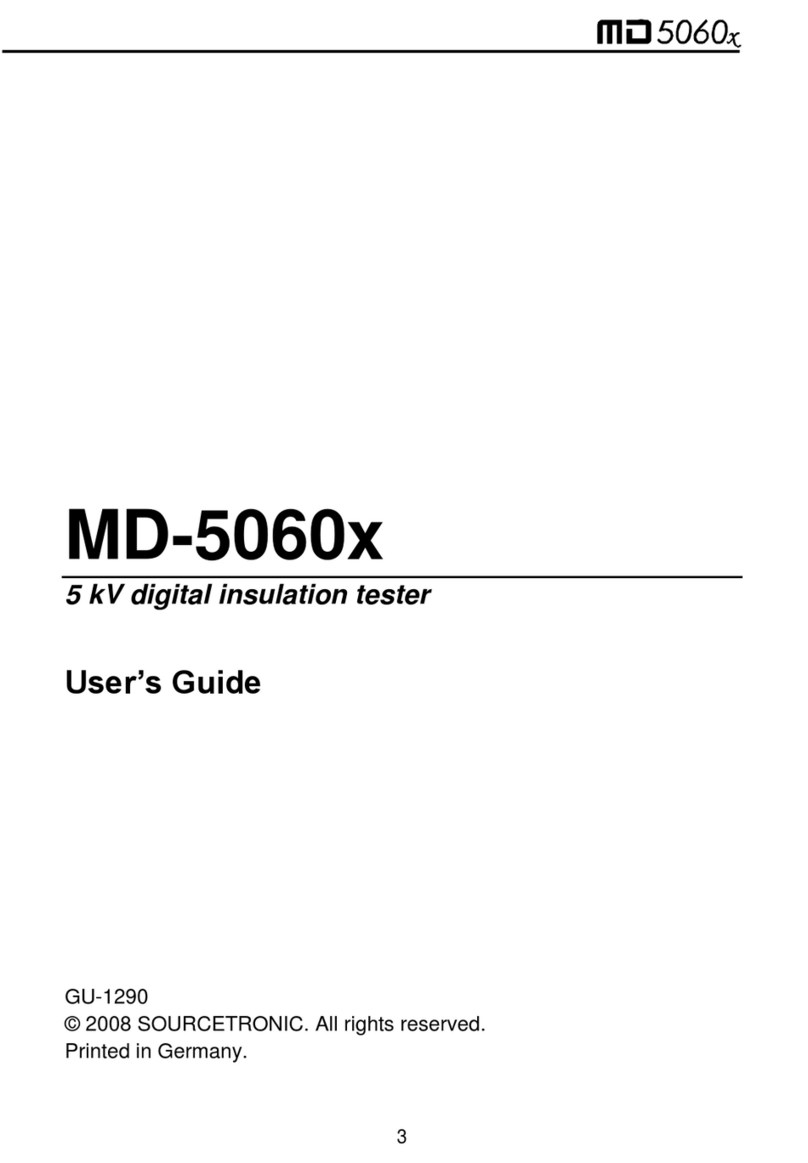SPX Power Team HT50A User manual

MODELS A, B, & C
IN-LINE HYDRAULIC TESTER
The 50 GPM (200 L/Min.) in-line hydraulic flow tester is a compact, self contained, portable instrument for testing
hydraulic systems in the shop or field. Before using the tester, read and understand these instructions.
SAFETY PRECAUTIONS
WARNING: To help avoid personal injury,
●Before operating the tester, all hose connections must be tighten with the proper tools. Do not
overtighten. Connections need only be tightened securely and leak-free. Overtightening may cause
premature thread failure or high pressure fittings to split at pressures lower than their rated capacities.
●Should a hydraulic hose ever rupture, burst, or need to be disconnected, immediately shut off the tester
and shift the control valve twice to release all pressure. Never attempt to grasp a leaking hose under
pressure with your hands. The force of escaping hydraulic fluid could cause serious injury.
●Do not subject the hose to any potential hazard such as fire, extreme heat or cold, sharp surfaces, heavy
impact. Do not allow the hose to kink, twist, curl, or bend so tightly that the oil flow within the hose is
blocked or reduced. Periodically inspect the hose for wear because any of these conditions can damage
the hose and result in personal injury.
●Do not use the hose to move attached equipment. Stress may damage the hose and cause personal
injury.
●Hose material and coupler seals must be compatible with the hydraulic fluid used. Hoses also must not
come in contact with corrosive materials such as creosote-impregnated objects and some paints.
Consult the manufacturer before painting a hose. Never paint the couplers. Hose deterioration due to
corrosive materials may result in personal injury.
IMPORTANT:
●Clean the areas around the oil ports of the tester.
●Inspect all threads and fittings for signs of wear or damage and replace as needed. Clean all hose ends.
couplers, or union ends.
●Seal all pipe connections with a high-grade, nonhardening thread sealant, such as Power Team HTS6.
Teflon tape may also be used to seal hydraulic connections, provided only one layer of tape is used.
Apply the tape carefully, two threads back, to prevent it from being
pinched by the coupler and broken off inside the pipe end.
Any loose pieces of tape could travel through the system and
obstruct the flow of oil or cause jamming of precision-fit parts.
Form No. 102546
HT50A
Operating Instructions for:
Sheet No. 1 of 3
Rev. 3 Date: 27 Aug. 1996
Note: Shaded areas
reflect last revision(s)
made to this form.
Tech. Services: (800) 477-8326
Fax: (800) 765-8326
Order Entry: (800) 541-1418
Fax: (800) 288-7031
SPX Corporation
5885 11th Street
Rockford, IL 61109-3699 USA
Internet Address:
http://www.powerteam.com
®
© SPX Corporation

Operating Instructions, Form No. 102546, Back sheet 1 of 3
NOTE:
●Adjustment of the pressure control valve may become difficult when connected into a closed center
system or when high back pressure is encountered.
●Each time the flow tester is connected to a hydraulic system for testing, the unit may be noisy the first
time pressure is increased with the pressure control valve. The noise is caused by air trapped in the
internal parts of the control valve. To flush air out, increase pressure to approximately 2000 PSI and then
back to 0 PSI.
●Oil the pressure control valve periodically.
Temperature Gauge
The oil temperature reading is constantly indicated on both a Fahrenheit (20-240°F) and Centigrade (-6-114°C) scale
on the temperature gauge.
PREPARATION AND SET-UP
The in-line hydraulic tester is shipped with plastic
plugs in the inlet and outlet ports. Two adapter unions
for 3/4" NPT male fittings in the inlet and outlet ports
are included. Remove the plastic plugs and install the
appropriate fittings and hoses. Save the plastic port
plugs for use during storage to prevent internal
contamination of the tester. See Figure 2.
TESTER COMPONENTS
Flow Gauge
The flow gauge is a single range gauge.
Pressure Gauge
Pressure readings are taken from a single fluid-filled
pressure gauge, 0-5000 PSI, 0-345 bar. An optional
conversion kit (#307281) is available to more
accurately isolate pressures in the 0-600 PSI range.
Pressure Control Valve
The pressure (load) control valve regulates system
pressure by restricting the flow to develop back
pressure in the system. To increase pressure, turn
the control valve clockwise; to reduce pressure, turn
control valve counterclockwise.
IMPORTANT: Before testing the system, open the
pressure control valve all the way by turning the
handle counterclockwise. Increase pressure
slowly and carefully.

Operating Instructions Form No. 102546
Overload Safety Relief Valve Disc
The INLET and OUTLET sides of the hydraulic tester are protected from excessive pressure by a Safety Relief Disc
Assembly (#16230).
If tested pressure exceeds the hydraulic pressure listed below, the disc ruptures, relieving the oil pressure before
damage may occur. When the disc bursts, the case will be filled with hydraulic oil.
The Safety Relief Valve Disc Assembly (#16230) must be replaced after it has burst. See Parts List for location.
NOTE: An extra Safety Relief Valve Disc Assembly is supplied with each unit.
Safety Disc Burst Range
50 GPM Tester. . . . . . . . . . . . . . . . . . . . . . . . 5510/6093 P.S.I. @ 60°F.
5250/5835 P.S.I. @ 160°F.
OPERATING PROCEDURE
1. Connect the pressure hose from the hydraulic system being tested to the "INLET" port of the hydraulic tester.
2. Connect the return hose to the "OUTLET" port of the hydraulic tester. It may be connected in series.
3. The pressure gauge in this hydraulic tester should not be subjected to sudden surge or shock loads. Any
pressure applied to a hydraulic system being tested must be obtained by operating the hydraulic tester restrictor
valve.
IMPORTANT: Open restrictor valve before and after each individual application of pressure.
4. After oil is flowing through the hydraulic tester, gradually increase the pressure to the desired setting.
5. This hydraulic tester will measure pressures up to 5,000 PSI (345 BAR). If the system being tested has no safety
valve in the line and cannot withstand 5,000 PSI (345 BAR), the restrictor valve MUST be open when starting the
test and the maximum pressure must be controlled by the operator.
When testing a system's relief valve, refer to the equipment manufacturer's service manual to determine the relief
valve setting. Turn the hydraulic tester's pressure control valve knob clockwise until the proper relief valve setting has
been reached.
When performing a direct pump test (as shown in Figure 3)
NEVER increase the pressure beyond the system's
maximum relief valve setting or serious damage to the pump
under test may result! Remember...during a direct pump
test, the relief valve has been completely by-passed and it
no longer protects the pump from excessive pressure. Refer
to equipment manufacturer's specifications for maximum
relief valve pressure...DO NOT permit reading on tester's
high pressure gauge to exceed that pressure! Before
testing the system, always open the pressure control
valve by turning the valve handle counterclockwise.
NOTE: The relief valve setting is easily recognized...the
pressure gauge needle will fluctuate, indicating
unloading or by-passing of oil over the relief valve, and
the GPM indicator will show a decrease in flow through
the tester, indicating that the balance of pump output is
going through the relief valve. Then, to obtain an
accurate flow reading, turn the pressure control valve
knob counterclockwise until the pressure level is
SLIGHTLY under the relief valve setting.
Connect the inlet port of the hydraulic tester to a "T"
connection installed between the pump and the directional
control valve (see Figure 4). Connect the outlet port of the
tester to the reservoir. Refer to manufacturer's specifications
for the test information. Sheet No. 2 of 3
Rev. 3 Date: 27 Aug. 1996

Operating Instructions, Form No. 102546, Back sheet 2 of 3
A TYPICAL TESTING PROCEDURE:
The following example will illustrate how this hydraulic tester is used to locate a hydraulic system malfunction. The
hydraulic system illustrated below consists of a reservoir, a pump, a relief valve, a directional control valve and a
double-acting cylinder. The problem: the cylinder's piston moves out at almost normal speed under no load, but
gradually slows down as the load increases. The trouble can lie anywhere in the system. First, all hoses and
connections should be checked for leakage, and if the trouble does not lie there, the hydraulic tester should be used
to check each of the system's components for efficiency.
TESTING THE PUMP . . . Step 1. See Diagram 1. Connect line (A) between hydraulic tester's outlet port and
system's reservoir. This connection can be maintained until all testing is completed. Step 2. Disconnect line (B)
between pump and relief valve. Connect line (C) between discharge port of pump and hydraulic tester's inlet port.
Next, open pressure control valve of hydraulic tester by turning knob counterclockwise. Turn pulsation
dampener knob counterclockwise several turns. Start pump. Set engine RPM for rated speed of pump (Equipment
manufacturer's specified RPM level for a given rate of flow). If the action of the gauges is erratic and severe pulsation
occurs, even after the dampener knob has been adjusted, cavitation of the pump may be indicated. . . Pressure
readings are made from tester's pressure gauge. When normal operating temperature is reached, open pressure
control valve by turning knob counterclockwise and refer to flow-meter gauge, recording volume at low pressure.
Increase pressure by turning knob clockwise, and record volume at increments up to maximum pressure. Open
pressure control valve and shut off pump. Now, check results against manufacturer's recommended ratings. If results
are low, the trouble is in the pump, suction line or filter. If results check, the trouble is beyond the pump, and we must
next check the relief valve. Disconnect line (C) between hydraulic tester's inlet port and discharge port of pump.
Reconnect line (B) between pump and relief valve.
TESTING THE RELIEF VALVE . . . See Diagram 2. Disconnect line (D) between relief valve and directional valve,
and connect line (E) between relief valve and tester's inlet port. Open pressure control valve. Turn dampener
temperature has been reached, record volume and pressure at various increments to maximum pressure. The
pressure at which the flow falls off to 0 is the relief pressure. If this pressure is below maximum operating pressure,
the relief valve should be adjusted. Up to relief pressure, flow should be the same as that of the pump. If it is not, this
is an indication that the relief valve is leaking and should be repaired. If the trouble does not lie in the relief valve, the
directional valve must be tested next. Disconnect line (E) between relief valve and hydraulic tester's inlet port.
Reconnect line (D) between relief valve and directional valve.
DIAGRAM 1 -- TESTING HYDRAULIC PUMP
DIAGRAM 2 -- TESTING RELIEF VALVE

Operating Instructions Form No. 102546
TESTING THE DIRECTIONAL VALVE . . . See Diagram 3. Disconnect line (F) between cylinder port (G) of
directional valve and pressure end (H) of cylinder. Connect line (J) between cylinder port (G) of directional valve and
hydraulic tester's inlet port. Open pressure control valve. Turn dampener knob counterclockwise several turns.
Start pump, set engine RPM for rated speed of pump. After operating temperature has been reached, shift directional
valve to direct oil from cylinder port (G) of directional valve to hydraulic tester's inlet port. Record pressure and
volume at various increments as was done in testing the pump and relief valve. If full volume and pressure cannot be
obtained, the directional valve is the cause of trouble, and must be repaired or replaced. If full rated volume at full
pressure is recorded, however, the trouble is in the cylinder.
TESTING WITH A "T" CONNECTION...
The above diagram illustrates a method of testing overall-circuit performance. Connect line (K) from hydraulic tester's
inlet port to a "T" connection in the circuit, as shown. Open tester's pressure control valve. Turn dampener knob
counterclockwise several turns. Start pump, set engine RPM for rated speed of pump. After operating temperature
has been reached, shift directional control valve to direct oil through relief valve (M), to cylinder port (L). Close
tester's pressure control valve partially to allow cylinder to extend and "dead-end."* Oil will flow to reservoir either
through the hydraulic tester or through leaks in components of the circuit. Read flow at no load. Increase load on
circuit by slowly closing the tester's pressure control valve and read flow at a pressure slightly below the relief valve
setting. The difference in readings indicates oil lost because of leaks somewhere in the circuit. Continue to increase
load until the indicated flow drops drastically, and take pressure reading. . . this reading indicates setting of relief valve
(M). To obtain setting of relief valve (N), shift directional control valve to direct oil to cylinder port (O) and repeat
procedure described above. To isolate the defective component, tests as described in Diagrams 1, 2 and 3 should be
used.
*If design characteristics of the cylinder make a "dead-end" inadvisable, simply plug the end of the line leading to the
cylinder.
DIAGRAM 3 -- TESTING DIRECTIONAL VALVE
DIAGRAM 4 -- TESTING WITH A "T"
CONNECTION
Sheet No. 3 of 3
Rev. 3 Date: 27 Aug. 1996
Table of contents
Other SPX Test Equipment manuals
Popular Test Equipment manuals by other brands
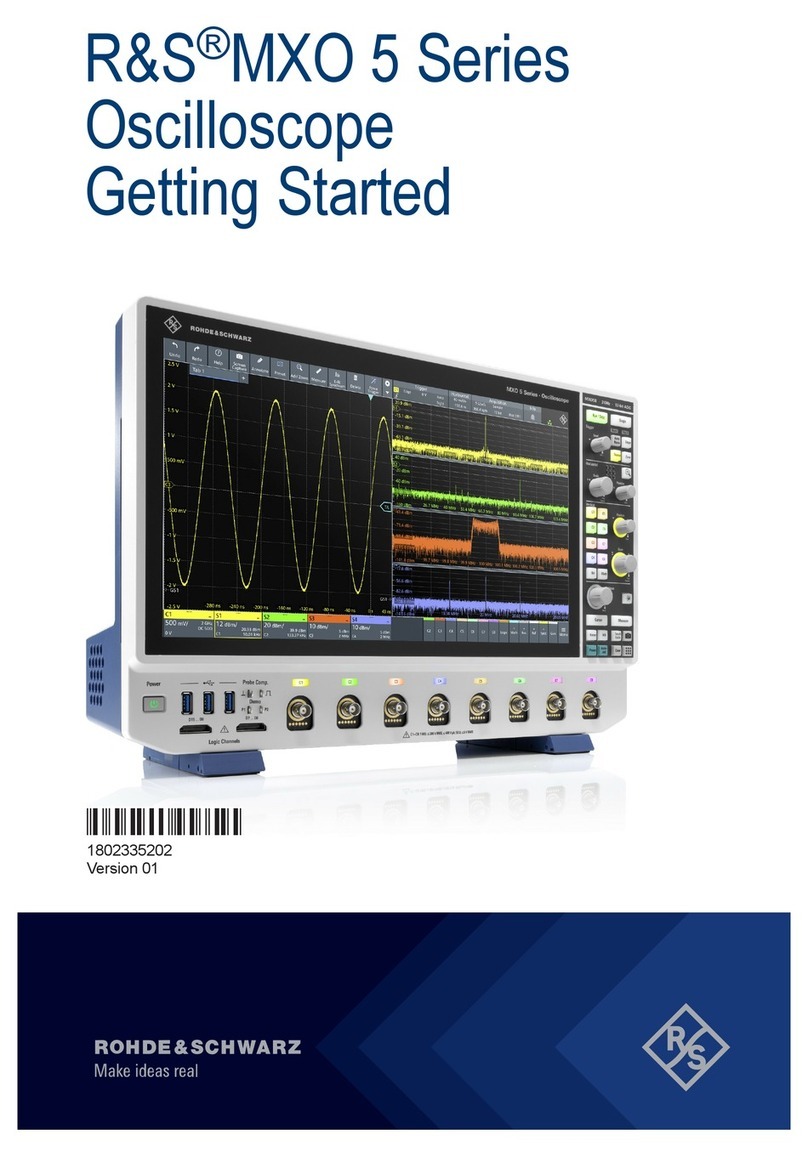
Rohde & Schwarz
Rohde & Schwarz R&S MXO 5 Series Getting started
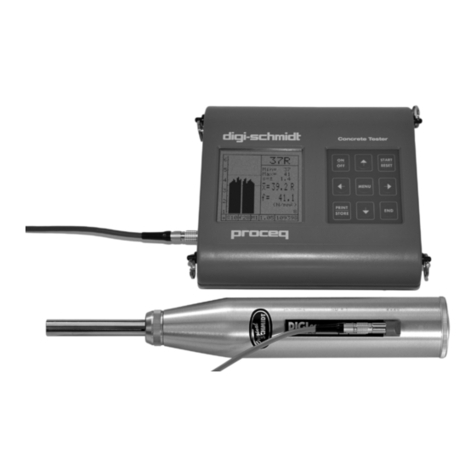
Proceq
Proceq DIGI-SCHMIDT 2000 LD operating instructions
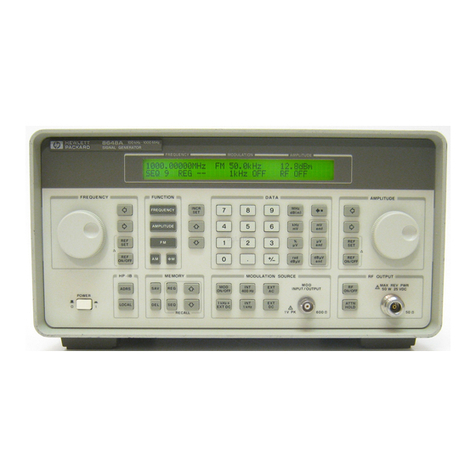
Agilent Technologies
Agilent Technologies 8648A Operation and service guide
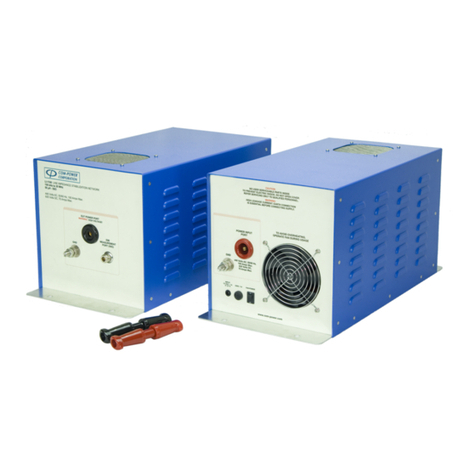
COM-power corporation
COM-power corporation LI-1100 instruction manual
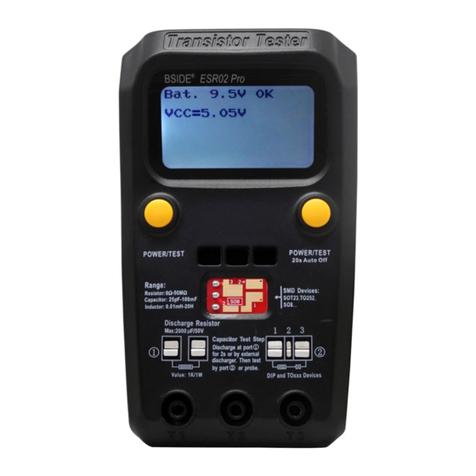
Bside
Bside ESR02 pro user manual

EXFO
EXFO bv10 installation guide

